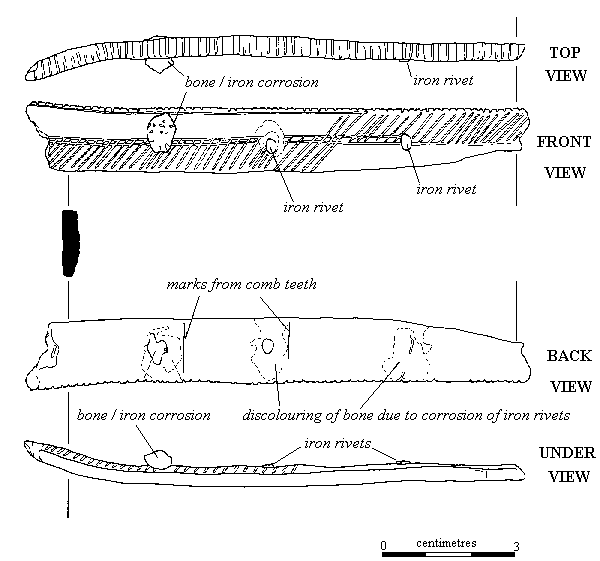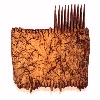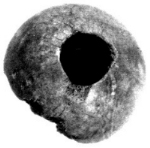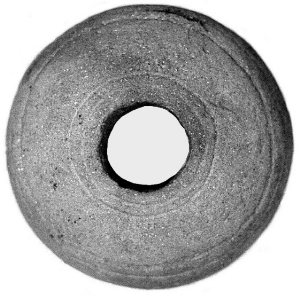 Bulletin
4, 1998
Bulletin
4, 1998
Early Medieval Artefacts from the Glebe Fields Excavations
A Preliminary Note
Cecily Spall
Excavations from the Glebe Field from 1996 to 1998 have yielded a small but significant assemblage of early medieval artifacts. Whilst none of these artifacts has been recovered from a primary context, they offer promising signs that an early medieval settlement awaits discovery in the strata below. The assemblage includes pieces of carved stone belonging to monuments (TR28, 35-38; Fig 7)), an eighth century coin from the Low Countries (Fig 8) and a fragment of a decorated copper alloy plaque already reported (Bull 2, Fig 8). The remaining assemblage to date (1998) comprises a fragment of glass (Fig 10), a small group of comb fragments (Fig11), nine dress pins (Fig 12) and a number of weaving artefacts (Fig 13). All these objects are provisionally dated to a period between the 8th and 11th centuries by reference to other early medieval sites, notably Whithorn in Galloway, and on Orkney the Brough of Birsay and Skaill.
Glass (Fig 10)
The small fragment (24/2885) displays a bichrome twisted rod of opaque yellow and olive green grounded on an olive green body sherd. This decoration and the shape of the fragment suggest that the sherd came from a vessel such as a beaker, small bowl or squat jar. Similar fragments occur at other sites in Scandinavia and Northern Europe between the late 7th and 9th centuries (Price in Hill 1997, 314). With the sceat (above) this constitutes the earliest evidence for pre-Viking contact across the North Sea.
Figure 10: Early medieval glass (24/2885)
Combs (Fig 11)
The comb -pieces comprise two side plates, two fragments of double-sided combs, and a single tooth, representing a minimum of five combs. The distinction between osseous (bone and ivory) and keratinaceous (horn and antler) materials is notoriously difficult and only possible through microscopic analysis of the composition of the material (and only in cases where it survives). In many cases worked, polished, carved or burnished skeletal materials have been worn beyond identification. However, in a given historical context certain materials were usuallyfavoured (Edwards 1990, 84) and provisional identification of one of the double-sided combs (Fernandez 1998) suggests that antler was favoured at Tarbat.
The double-sided composite comb (24/1548) carries a criss-cross decoration and is parallelled by examples from Pictish period sites at Buckquoy (Ritchie in Curle 1983, 59,5.5), Saeverhowe and Skaill (Buteux 1997, Fig 8.1, 10, 12, 13). These combs resemble those depicted with hand mirrors on Pictish symbol stones, for example on Dunrobin 1, which features criss-cross ornament, and on the stone from Dairy Park, Dunrobin which displays a double-sided composite comb complete with three rivets.
The small fragment of fine-toothed comb (24/1805) shows no sign of having had side plates. It is very similar to an almost complete example found at Whithorn (Hill 1997, Fig 10.138, 5.1). Another example, exhibited in Kirkwall Museum, is dated to the Norse period. These combs resemble those used up to the present day for removing nits from the hair.
Two pieces of side-plate, one decorated with slashes (14/271, Fig 11) and the other undecorated (24/48, not illustrated), are parallelled at Whithorn, Birsay and the Irish site of Knowth and are characteristic of examples dated elsewhere to the Viking/Norse period (Edwards 1990, Fig 37; Hill 1997, 483, Fig 68.2).
The single tooth has dimensions close to the composite double-sided comb, so probably came from a dress comb rather than a nit comb. Horizontal striations show that it has been worn from use and is not a fragment of manufacturer's waste.
 |
|
 24/1805 |
|
Figure 11: A Selection of Combs from Sector 2
Horn, antler, bone or ivory pins (Fig 12)
Three fragments of pin have been broken in antiquity or are undecorated making identification difficult (11/2645, 14/59, 14/307; not illustrated). Four examples are complete or display diagnostic elements, and, whilst it is uncommon for two pins to be exactly the same (Nicholson in Hill 1997,366), the Tarbat pins are similar to examples found at Whithorn, Caithness and Skaill in early medieval deposits. A simple burnished bone pin (24/916) has a Norse parallel from a burial in Caithness (Batey et al 1993, Fig 6.1) and from Skaill (Buteux 1997, Fig 8.4.51, 33). A pin with a splayed head (14/1284) has superficial parallels with three pins found at Whithorn (Hill 1997, Fig 10.138.7.1-3).
The two ivory pins were recovered together redeposited in a late medieval layer. The smaller of the two displays ornament similar to that on Hiberno-Norse stick-pins from Whithorn (Hill 1997, Fig 10.54.44) and although this parallel was cast in copper alloy, it is widely accepted that bone pins are either exemplars or alternatives to their metal counterparts. Indeed it has been suggested that bone pins were used to form the ceramic moulds from which metal pins were cast (Edwards 1990,86). As regards the decoration on the smaller pin (24/746), three pins found within a building from a Pictish horizon on the Brough of Birsay show very similar head decoration in the form of stamped dots, in this case five dots arranged like the face of a die (Curle 1983,73,20-2).
Copper alloy pins(Fig 12)
Two decorated copper alloy pins have been found. One example shows a typical club head with collar (24/527) and the other (24/504) has a club or 'mushroom' head. Both these types of head are characteristic of the Hiberno-Norse stick-pins from Dublin (O'Rahilly in Hill 1997, 365-7) and may be dated to the 9th to 11th century.
 14/1284 |
 14/59 |
 24/747 |
 24/746 |
 24/527 |
 24/504 |
Figure 12: Bone and copper alloy pins from sector 2
Weaving artifacts (Fig13)
Two artifacts associated with the production of textiles have been found. A sandstone loom-weight (14/1576) has six concentric incised lines and the object may have been made on a lathe. It may be parallelled by examples from Saxon contexts at the Royal Opera House site in London (Current Archaeology, 158, 1998: 61).
A bone spindle whorl (24/2139) has parallels from early medieval sites in Ireland (Edwards 1990, 81, Fig 34c), Whithorn (Hill 1997, Fig 10.137, 106) and Skaill, Orkney (Buteux 1997, Fig 8.6, 13, 31, 49, 917).
 24/2139 |
 14/1576 |
Figure 13: Examples of loom wetights from sector 2
Conclusion
The early medieval assemblage is dominated by material which is Norse in association and thus probably 9th-11th century in date. However, the settlement of the Norse period is likely to have been preceded by one of 7th-9th century Pictish date, as suggested by a smaller group of artifacts . These include a comb (24/1548), the glass fragment (24/2885), the sceat (24/2283) and pieces of carved stone (TR28, 35-38). In the excavations undertaken up to now, recognisable artifacts from prehistoric or medieval date are much less numerous than those dated to the 7th-11th century which probably represent the principal time span being encountered in the Glebe Field.
NEXT: Comments
BACK: Medieval Pottery
Last updated 10 October, 2003.
Contact the Tarbat Discovery Programme



